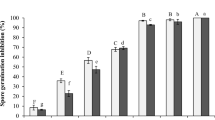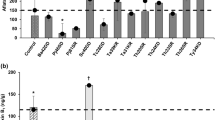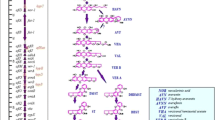Abstract
This study evaluated the ability of the microorganisms Rhizopus oryzae (CCT7560) and Trichoderma reesei (QM9414), producers of generally recognized as safe (GRAS) enzymes, to reduce the level of aflatoxins B1, B2, G1, G2, and M1. The variables considered to the screening were the initial number of spores in the inoculum and the culture time. The culture was conducted in contaminated 4 % potato dextrose agar (PDA) medium, and the residual mycotoxins were determined every 24 h by HPLC-FL. The fungus R. oryzae has reduced aflatoxins B1, B2, and G1 in the 96 h and aflatoxins M1 and G2 in the range of 120 h of culture by approximately 100 %. The fungus T. reesei has reduced aflatoxins B1, B2, and M1 in the 96 h and aflatoxin G1 in the range of 120 h of culture by approximately 100 %. The highest reduction occurred in the middle of R. oryzae culture.

Similar content being viewed by others
References
Agência Nacional de Vigilância Sanitária (ANVISA) (2011) RE no. 7, de 2 de fevereiro de 2011
Alberts JF, Gelderblom WCA, Botha A, Van Zyl WH (2010) Degradation of aflatoxin B1 by fungal laccase enzymes. Int J Food Microbiol 135:47–52
Association Official Analytical Chemists (2000) Official methods of analysis of AOAC International, 17th edn. AOAC, Arlington
Cacciamani JLM, Garda-Buffon J, Badiale-Furlon E (2007) Fungal Fermentation: proteic enrichment and mycotoxins degradation in cereal bran contaminated by aflatoxin B1 and Ochratoxin A. J Braz Food Technol 10:233–239
Carbone I, Ramirez-Prado JH, Jakobek JL, Horn BW (2007) Gene duplication, modularity and adaptation in the evolution of the aflatoxin gene cluster. Biomed Cent Evol Biol 7:1–12
Dors GC, Pinto LAA, Furlong EB (2009) Migration of mycotoxins into rice starchy endosperm during the parboiling process. Food Sci Technol Int 42:433–437
Firmin S, Gandia P, Morgavi DP, Houin G, Jouany JP, Bertin G, Boudra H (2010) Modification of aflatoxin B1 and ochratoxin A toxicokinetics in rats administered a yeast cell wall preparation. Food Addit Contam 27:1153–1160
Food and Drug Administration FDA/CFSAN (2003) Bad bug book: aflatoxins
Garda J, Maceo RM, Farias R, Bernd L, Dors GC, Furlong EB (2005) Alcoholic fermentation effects on malt spiked with trichothecenes. Food Control 16:423–428
Garda-Buffon J, Badiale-Furlong E (2010) Kinetics of deoxynivalenol degradation by Aspergillus oryzae and Rhizopus oryzae in submerged fermentation. J Braz Chem Soc 21:710–714
Garda-buffon J, Kupski L, Badiale-Furlong E (2011) Degradação de deoxinivalenol (DON) e a atividade da enzima peroxidase durante fermentação submersa. Cienc Tecnol Aliment 31:198–203
Guan S, Ji C, Zhou T, Li J, Ma Q, Niu T (2008) Aflatoxin B1 degradation by Stenotrophomonas maltophilia and other microbes selected using coumarin medium. Int J Mol Sci 9:1489–1503
Guo X, Li D, Lu W, Piao X, Chen X (2006) Screening of Bacillus strains as potential probiotics and subsequent confirmation of the in vivo effectiveness of Bacillus subtilis MA139 in pigs. Antonie van Leeuwenhoek. Int J Gen Mol Microbiol 90:139–146
Gutarowska B, Zakowska Z (2009) Mathematical models of mycelium growth and ergosterol synthesis in stationary mould culture. Lett Appl Microbiol 48:605–610
Heidtmann RB, Hackbart HCS, Souza MM, Dors GC, Fagundes CAA, Furlong EB (2012) Determinação de deoxinivalenol e zearalenona em arroz natural e parboilizado e suas frações utilizando QuEChERS e HPLC/UV-FL. Quim Nova 35:1244–1249
International Agency for Research on Cancer (1993) Some naturally occurring substances: food items and constituents, heterocyclic amines and mycotoxins. Monographs on evaluation of carcinogenic risk to humans, No. 56. IARC, Lyon
Instituto Nacional de Metrologia, Normalização e Qualidade Industrial (INMETRO) (2003) Orientações sobre Validação de Métodos de Ensaios Químicos, DOQ-CGCRE-008. Revisão: 01, 2003
Karmakar M, Ray RR (2011) Current trends in research and application of microbial cellulases. Res J Microbiol 6:41–53
Khlangwiset P, Shephard GS, Wu F (2011) Aflatoxins and growth impairment: a review. Crit Rev Toxicol 41:740–755
Khlangwiset P, Wu F (2010) Costs and efficacy of public health interventions of reduce aflatoxina-induced human disease. Food Addit Contam 27:998–1014
Kusumaningtyas E, Widiastuti R, Maryam R (2006) Reduction of aflatoxin B1 in chicken feed by using Saccharomyces cerevisiae, Rhizopus oligosporus, and their combination. Mycopathologia 162:307–311
Motomura M, Toyomasu T, Mizuno K, Shinozawa T (2003) Purification and characterization of an aflatoxin degradation enzyme from Pleurotus ostreatus. Microbiol Res 158:237–242
Oliveira MS, Badiale-Furlong E (2008) Screening of antifungal and antimycotoxigenic activity of plant phenolic extracts. World Mycotoxin J 1:1–10
Oliveira M, Feddern V, Kupski L, Cipolatti E, Furlong EB, Souza-Soares L (2011) Changes in lipid, fatty acids and phospholipids composition of whole rice bran after solid-state fungal fermentation. Bioresour Technol 102:8335–8338
Saalia FK, Phillips RD (2010) Degradation of aflatoxins in aqueous buffer in the presence of nucleophiles. Food Control 21:1066–1069
Schimidt CG, Furlong EB (2012) Effect of particle size and ammonium sulfate concentration on rice bran fermentation with the fungus Rhizopus oryzae. Bioresour Technol 123:36–40
Silveira CM, Badiale-Furlong E (2007) Separate effects of solid-state fermentation in the functional properties of defatted rice bran and wheat bran. Braz Arch Biol Technol 52:1555–1562
Souza MM, Prietto L, Ribeiro AC, Souza TD, Furlong EB (2012) Assessment of the antifungal activity of spirulina platensis phenolic extract against aspergillus flavus. Ciênc Agrotecnol (UFLA) 35:1050–1058
Soares LMV, Rodriguez-Amaya DB (1989) Survey of aflatoxins, ochratoxin A, zearalenone and sterigmatocystin in some Brazilian foods by using multi-toxin thin-layer chromatographic method. J Assoc Off Anal Chem 72:22–26
Yu J, Chang PK, Ehrlich KC, Cary JW, Bhatnagar D, Cleveland TE, Payne GA, Linz JE, Woloshuk CP, Bennett JW (2004) Clustered pathway genes in aflatoxin biosynthesis. Appl Environ Microbiol 70:1253–1262
Conflict of interest
None
Author information
Authors and Affiliations
Corresponding author
Rights and permissions
About this article
Cite this article
Hackbart, H.C.S., Machado, A.R., Christ-Ribeiro, A. et al. Reduction of aflatoxins by Rhizopus oryzae and Trichoderma reesei . Mycotoxin Res 30, 141–149 (2014). https://doi.org/10.1007/s12550-014-0202-6
Received:
Revised:
Accepted:
Published:
Issue Date:
DOI: https://doi.org/10.1007/s12550-014-0202-6




